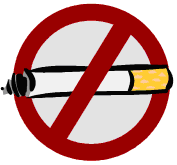 Although the damage you may be doing to your lungs cannot readily be seen, the damage that smoking does to your smile is much more evident. Not only can smoking diminish the brightness of your smile, tobacco — in any form — can cause significant disease in your mouth.
Although the damage you may be doing to your lungs cannot readily be seen, the damage that smoking does to your smile is much more evident. Not only can smoking diminish the brightness of your smile, tobacco — in any form — can cause significant disease in your mouth.
The following conditions can be brought on or exacerbated through the smoking and the use of tobacco products.
- Oral cancer
- Bad breath, due to greater tartar build-up on teeth
- Gum disease (Periodontal disease)
- Stained teeth and tongue
- Diminished sense of taste and smell
- Delayed healing following a tooth extraction or other oral surgery
- Difficulties in correcting cosmetic dental problems
- Fewer options for some kinds of dental care
Dr. Sophocles and our staff can assist you in your efforts to stop smoking. Call our office at (610) 566-3326 to schedule an oral cancer screening.
Frequently Asked Questions about Quitting Smoking
What are the benefits of quitting smoking?
Some of the benefits include:
- Reduced risk of developing oral, lung and other cancers
- Improved sense of taste and smell
- Less stress on the heart and lower blood pressure
- Saving money
What are some ways that I can quit smoking?
Some of the effective ways to quit smoking include:
- Joining a smoking cessation program
- Chewing sugarless gum to keep your mouth occupied
- Exercising
- Using self-help books, pamphlets, video tapes, etc.
- Gaining the support of your family, friends, dentist and physician
Frequently Asked Questions about Smokeless Tobacco
Are the effects smokeless tobacco (chew or dip) the same as smoked tobacco?
Yes. The use of smokeless tobacco causes:
- Bad breath
- Permanent tooth stains
- Gums to pull away from the teeth, exposing the roots and making teeth more sensitive and prone to decay
- Tooth decay, as a result of the sugar added to chewing tobacco
- Sores and painful patches on the lips and mouth
How does the use of smokeless tobacco cause oral cancer?
Smokeless tobacco products contain at least 28 cancer-causing chemicals. Individuals whose mouths are exposed to those chemicals are at a greater risk of getting oral cancer. Use of smokeless tobacco increases the risk of oral cancer by approximately 50 times.
What are the overall health risks of using smokeless tobacco?
Individuals who use smokeless tobacco are subject to overall health risks including:
- Sick stomach feelings from swallowing tobacco juice
- Increased blood pressure and heart rate, which increases the risk of heart attacks
- Moodiness, headaches and trouble sleeping and concentrating when trying to quit
Frequently Asked Questions about Oral Cancer

Oral cancer on the tongue
Who is most at risk for oral cancer?
Oral cancer most often strikes adults over the age of 40 and affects twice as many men than women. Those individuals who use any form of tobacco products, especially combined with the use of alcohol, are at increased risk for oral cancer. However, more than 25 percent of oral cancers occur in non-smokers with no other risk factors.
How can I lower my risk for oral cancer?
Oral cancer can be prevented by eliminating risk factors such as tobacco product use and excessive alcohol consumption. Using a lip balm that contains sunscreen also will reduce the risk of lip cancer. Additionally, studies indicate that eating fruits and vegetables as part of a low-fat, high-fiber diet may reduce the risk of cancer.
What are some of the symptoms for oral cancer?
Symptoms of oral cancer include:
- Sores in the mouth or on lips that do not heal
- A lump or discolored patches on the inside of the mouth
- Difficulty chewing, swallowing, or moving the jaw and tongue
- Swelling of the jaw that changes the way teeth fit together or how dentures fit
- Pain or numbness in parts of the mouth
If you are experiencing any of the symptoms listed above, contact your dentist immediately.
How can I detect early signs of oral cancer?
Your dentist can teach you how to perform a self-examination, which you should perform monthly. Also, be sure to make regular visits to your dentist for cleaning examinations. If your dentist identifies an area of concern, he or she can test it to determine whether or not the area is cancerous.
